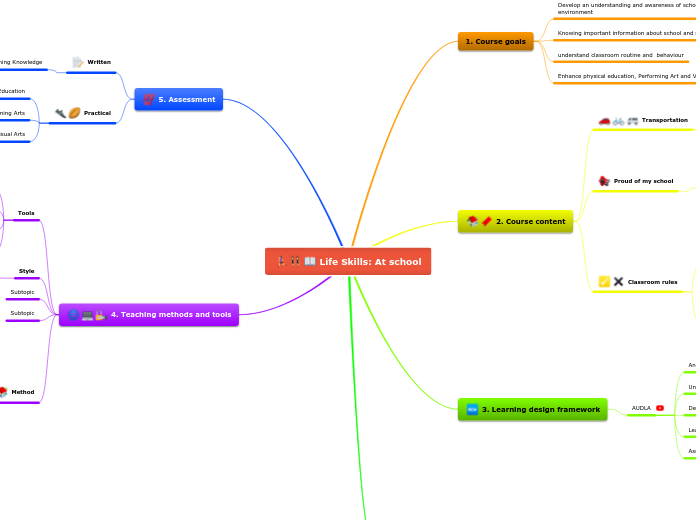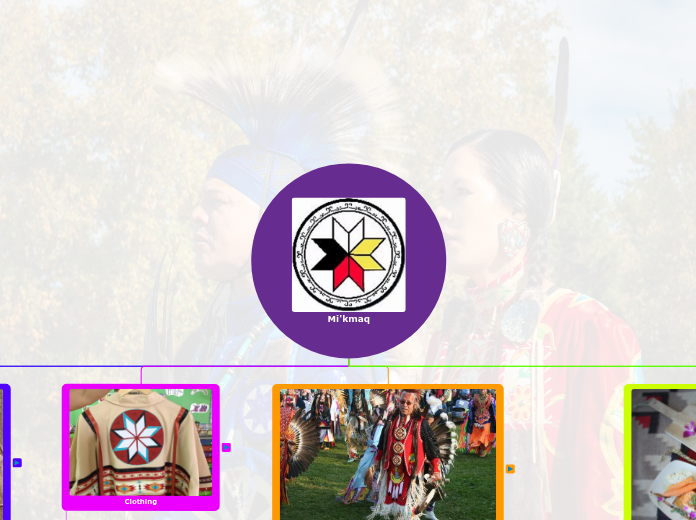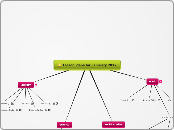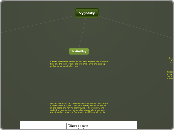Life Skills: At school
Type in the title of your course.
4. Teaching methods and tools
Select methods and tools according to
- the size of the class
- the course goals
Method
Role playing
Song and dance
Direct instruction
Game based learning
Collaboration
Flipped classroom
Don't forget to take into consideration if these methods can help you achieve the course goal too.
Subtopic
Style
Inclusive
How do you plan to apply your style to suit the course goals, the size of the class, and the students?
Tools
Helping tools
QuickTime Player
Wisc-online
Decide whether you will use technology in your teaching or not. Look for a tool which will help you reach specific goals.
Also, consider your students' possibilities of accessing that tool.
Google forms
Decide whether you will use technology in your teaching or not. Look for a tool that will help you reach specific goals.
Also, consider your students' possibilities of accessing that tool.
5. Assessment
The evaluation must go hand-in-hand with course goals in order to achieve them and also help students to improve their skills.
Also, assignments and homework need to reflect and help achieve course goals.
Practical
These can be partial - short evaluations after each segment of the course - or final - a final exam which will assess all the knowledge aquired during the school year at once.
Visual Arts
Drawing
Performing Arts
Dancing
Physical Education
Locomotor skills
Written
Decide if you want the assignments completed during the year to represent 1/3 of the final grade.
Beginning Knowledge
Quiz
Student interface
- Chronological - you can organize the topics according to a theme or storyline.
- Topical order - involves taking the topic of your speech and dividing it into several subtopics. The subtopics are related to the topic they branch out from.
- Survey-oriented - this type of course structure is briefly treating the main topics of a broad field of knowledge.
- A process-oriented syllabus focuses on the skills and processes involved in learning.
ChronologicalTopicalSurvey-orientedProcess-oriented
Talent Learning Management System
3. Learning design framework
Arrange the topics in a logical order.
Discuss how and why you have organized the material in a particular way.
This will help students to see the connections between topics.
AUDLA
Assessment
Learning
Design
Universal
Analysys
2. Course content
Select the major topics and determine the order in which you will teach them.
Classroom rules
You can change your initial list of topics. You can add more material or interesting facts on the subject if your time allows it.
You can even add to the list some movies that are worth watching and will help you to achieve your goal.
Bad behaviour
No eating
Do not fight
Good behaviour
Raise your hand to talk
Keep class clean
Raising your hand to talk
Proud of my school
Important information about the school
People who work at the school
different locations at the school
Name of school, teacher principal
Transportation
Select the main topics to be covered. To obtain an initial list of course topics, search in current textbooks or in the current literature.
Safe ways of traveling to and from school
stay away from strangers, always walk in groups
1. Course goals
Determine the goals of the course.
Having these course goals in mind will then help you make decisions about which content to include and what kind of assignments and exams are appropriate.
Consider the following questions:
- What you want your students to remember from your course?
- What skills should students gain in this course?
- How does this course relate to other courses in the discipline?
Enhance physical education, Performing Art and Visual Arts
understand classroom routine and behaviour
Knowing important information about school and self
Develop an understanding and awareness of school environment









